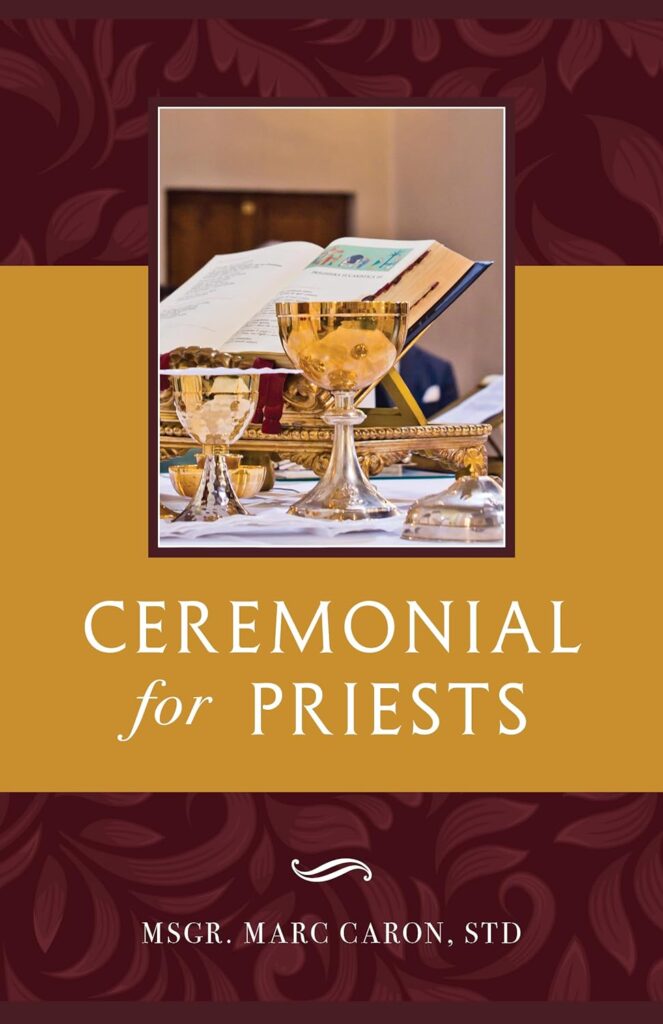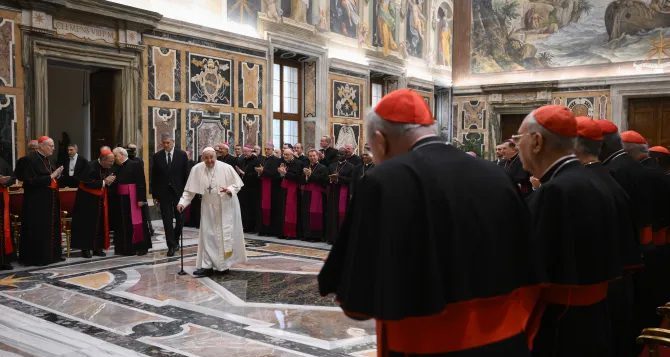
On February 2, 2024, the Dicastery for the Doctrine of the Faith issued Gestis verbisque, a document dealing with essentials of form, matter, and intention prerequisite to valid celebration of a sacrament. Gestis suggests that it was occasioned by the growth in cases in which bishops are compelled to examine the validity of a person’s baptism (and, thus, the rest of his sacramental life) that has been called into question through defect of form.
The proliferation of these cases is the result of ideologically driven decisions by some sacramental ministers to substitute their own language for the Church’s sacramental form. Those decisions were often fueled by “inclusive language” or “ecclesiological” agendas, resulting in invalidation of the sacrament. The most dramatic public case to date is the Rev. Matthew Hood of Detroit, whose invalid baptism (which he discovered by watching a family video of the event) also thereby invalidated his ordination.

Valid administration of baptism is not rocket science. Once upon a time, children used to learn as part of catechism what was required to baptize somebody “in danger of death.” And, once upon a time, when seminarians were enrolled in liturgical practicum to teach them to be celebrants, the whole course could be summed up in six words: “read the black, do the red,” i.e., speak what was in black print, follow the instructions in red.
The raison d’être of a priest is to bring people to God, which always has some sacramental or liturgical connection if not an explicit context. For that reason, the ars celebrandi is not something marginal for priests, something he just “picks up” as he goes along. We’re still at a juncture in the Church’s history where we’ve seen both sides of the pendulum: priests who remember pre-Vatican II rites also remember a strict—perhaps sometimes even scrupulous—rubricism, while the post-Conciliar period has often been marked by a kind of liturgical antinomianism. The latter was unwarranted, inasmuch as Sacrosanctum Concilium (22) made it clear that priests were not to tamper with the rites and the reformed rites always contained instructions for proper celebration. That Gestis verbisque had to be issued suggests not everybody was reading those instructions.
That’s why Msgr. Caron’s book fills an important niche. The book provides a comprehensive, 39-chapter guide for celebration of Mass and the sacraments throughout the liturgical year. Its author is amply qualified: a parish priest and chancery official of the Diocese of Portland, ME, he served for 14 years as diocesan master of ceremonies and four as professor of liturgy and sacraments at St. John’s Seminary in Brighton, MA, with a licentiate in liturgy from The Catholic University of America and a doctorate in theology from the University of St. Mary of the Lake in Mundelein, IL.
The book is divided into six parts. Part One focuses on “celebration of the Mass,” both the “source and summit of the Christian life” as well as a priest’s foundational daily act. Caron’s treatment is all-inclusive: “gestures” (e.g., walking, bowing, kneeling, genuflecting, making signs of the cross, hand placement); preparing for Mass (with explicit lists of “liturgical equipment” pre-positioned in various places in church); and incense at Mass. Celebration of the Mass is presented in detail, from entering the church through exiting it. That Part One runs 88 pages indicates the detail of the treatment.
Part Two addresses “Matters Related to the Celebration of the Mass.” The most valuable chapter focuses on variations when Mass is celebrated ad orientem. Another chapter speaks to celebrations when one or no ministers are present or when no congregation is present. Tucking the treatment of Mass with the faithful in the absence of any minister in this chapter among “unusual circumstances” makes logical sense but seems a little odd: that configuration is likely the statistical norm in many parishes on weekdays. In light of Gestis, Caron’s treatment of intention is valuable: his advice is “[t]he priest should have the habitual intention of consecrating everything placed on a corporal on the altar for the celebration of Mass” (131)—even if it requires multiple corporals. This part of the book also contains a discussion of “Eucharistic Worship Outside Mass,” including distribution of Communion outside Mass (with instructions on Sundays in the absence of a priest) and Exposition and Benediction of the Blessed Sacrament. The recovery of Eucharistic devotion today may render more clergy familiar with the rites of Exposition and Benediction, but I cannot shake memories of a deacon I met in the early 1980s who, assigned to lead Exposition, asked, “What is that?”
Part Three deals with variations on liturgical themes occasioned by the Church year. Some of them are big and intimidating, e.g., the many differences in the liturgies of the Paschal Triduum, with each of the three Great Days receiving a chapter-length treatment. Some are small but should not be overlooked, e.g., the substitution of genuflection for bowing upon mention of the Incarnation during the Profession of Faith on Christmas and the Annunciation. Some are unique and universal, e.g., imposition of ashes on Ash Wednesday; some had fallen into neglect and are only now being recovered, e.g., the proclamation of moveable feasts on Epiphany or a cemetery procession on All Souls’ Day. Having all these differences in one place is useful, especially in terms of preparation for their celebration.
Part Four deals with the sacraments, both when celebrated as part of Mass and individually. That obviously does not apply to Penance, though Caron has a chapter on the rite of Reconciliation, distinguishing the sacrament from penitential services not connected to confession and absolution. Confirmation is treated briefly in conjunction with rites for the initiation of an adult; its fuller discussion is later, among celebrations with a bishop. Part Four also includes guidance for funeral Masses and when parts of the Liturgy of the Hours are celebrated either individually or during Exposition of the Blessed Sacrament.
Many priests will likely find Part Five alone worth buying the book. “The Roles for Priests and Deacons in Parish Celebrations by a Bishop” talks about liturgical variations arising from when a bishop visits or celebrates. Caron treats Mass in which the bishop is principal celebrant and Confirmation administered by the bishop, whether within or outside of Mass.
Part Six, another 50 pages, is a useful supplement to Part One. “Ceremonial for Small Congregations Described” offers practical advice for liturgies celebrated in small parishes, where ministers may be few to none and the faithful limited.
The book is rounded out with an appendix containing nine diagrams illustrating a variety of functions, from where the altar is incensed when the celebrant arrives at it (including adaptation when the altar is not circumambulatory) to the sequence of incensing the presented gifts as well as order for participants in processions at solemn Masses, Masses with a bishop, and Corpus Christi processions.
I appreciate what I would call Caron’s “hermeneutic of rubrical continuity.” While post-Conciliar liturgical directives exist, they are, in general, less detailed than earlier ones. Although Vatican II prescribed a “noble simplicity” to the rites (Sacrosanctum Concilium, 34), one suspects the Council Fathers did not envision a rubrical tabula rasa. They did not intend priests to be improv artists. Caron follows the norms but, where matters are unclear, he does not hesitate to look to how something was handled in the past. The Church, after all, has been celebrating the liturgy every day for centuries, accruing much wisdom through that practice. Caron is, however, clear when he relies on commentaries or extrapolates.
When I first approached this book, I was a little put off. Caron’s somewhat detailed discussion of where and how the priest should put his hands during the Roman Canon, for example, initially struck me as a return to Henry Davis’s Moral and Pastoral Theology, an influential work for English-speaking priests in the early-to-mid 20th century. I imagined Davis may have contributed to cases of scrupulosity as to what kind of “moral fault” might be involved depending on how vincible was one’s knowledge of the wrong number of altar cloths. But I’m now convinced Caron does not do that. He does provide a very useful service whose relevance Gestis verbisque seems to confirm: how to celebrate the liturgy properly. That is both a perennial undertaking and a proper one 60 years out from Vatican II.
If I can suggest a follow-up book, it would be great to adapt this book and its checklists, at least in terms of Mass, for ministers of the altar.


